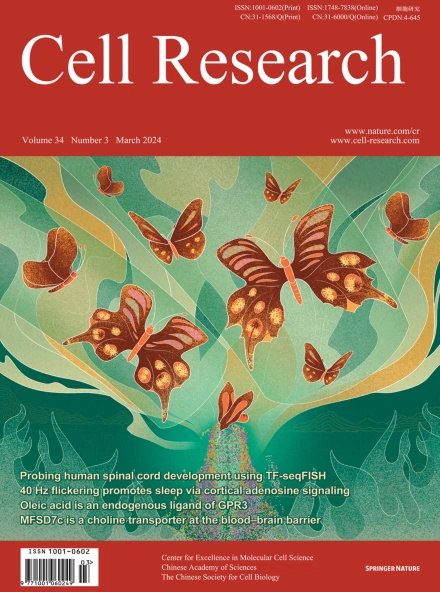
Advanced Search
Submit Manuscript
Advanced Search
Submit Manuscript
Volume 34, No 3, Mar 2024
ISSN: 1001-0602
EISSN: 1748-7838 2018
impact factor 17.848*
(Clarivate Analytics, 2019)
Volume 34 Issue 3, March 2024: 232-244 |
Identification of oleic acid as an endogenous ligand of GPR3
Yangjie Xiong1,† , Zhenmei Xu1,† , Xinzhi Li1,† , Yuqin Wang1,† , Jing Zhao2,† , Na Wang1 , Yaning Duan1 , Ruixue Xia1 , Zhengbin Han1 , Yu Qian1 , Jiale Liang1 , Anqi Zhang1 , Changyou Guo1 , Asuka Inoue3 , Yu Xia2,* , Zheng Chen1,4,* , Yuanzheng He1,4,*
1HIT Center for Life Sciences, School of Life Science and Technology, Harbin Institute of Technology, Harbin, Heilongjiang, ChinaAlthough GPR3 plays pivotal roles in both the nervous system and metabolic processes, such as cold-induced thermogenesis, its endogenous ligand remains elusive. Here, by combining structural approach (including cryo-electron microscopy), mass spectrometry analysis, and functional studies, we identify oleic acid (OA) as an endogenous ligand of GPR3. Our study reveals a hydrophobic tunnel within GPR3 that connects the extracellular side of the receptor to the middle of plasma membrane, enabling fatty acids to readily engage the receptor. Functional studies demonstrate that OA triggers downstream Gs signaling, whereas lysophospholipids fail to activate the receptor. Moreover, our research reveals that cold stimulation induces the secretion of OA in mice, subsequently activating Gs/cAMP/PKA signaling in brown adipose tissue. Notably, brown adipose tissues from Gpr3 knockout mice do not respond to OA during cold stimulation, reinforcing the significance of GPR3 in this process. Finally, we propose a “born to be activated and cold to enhance” model for GPR3 activation. Our study provides a starting framework for the understanding of GPR3 signaling in cold-stimulated thermogenesis.
https://doi.org/10.1038/s41422-024-00932-5